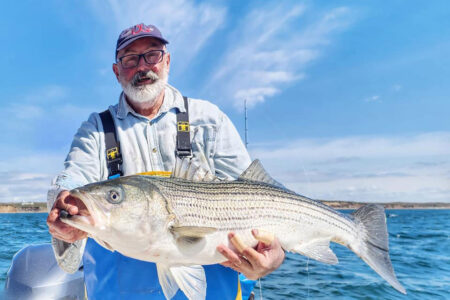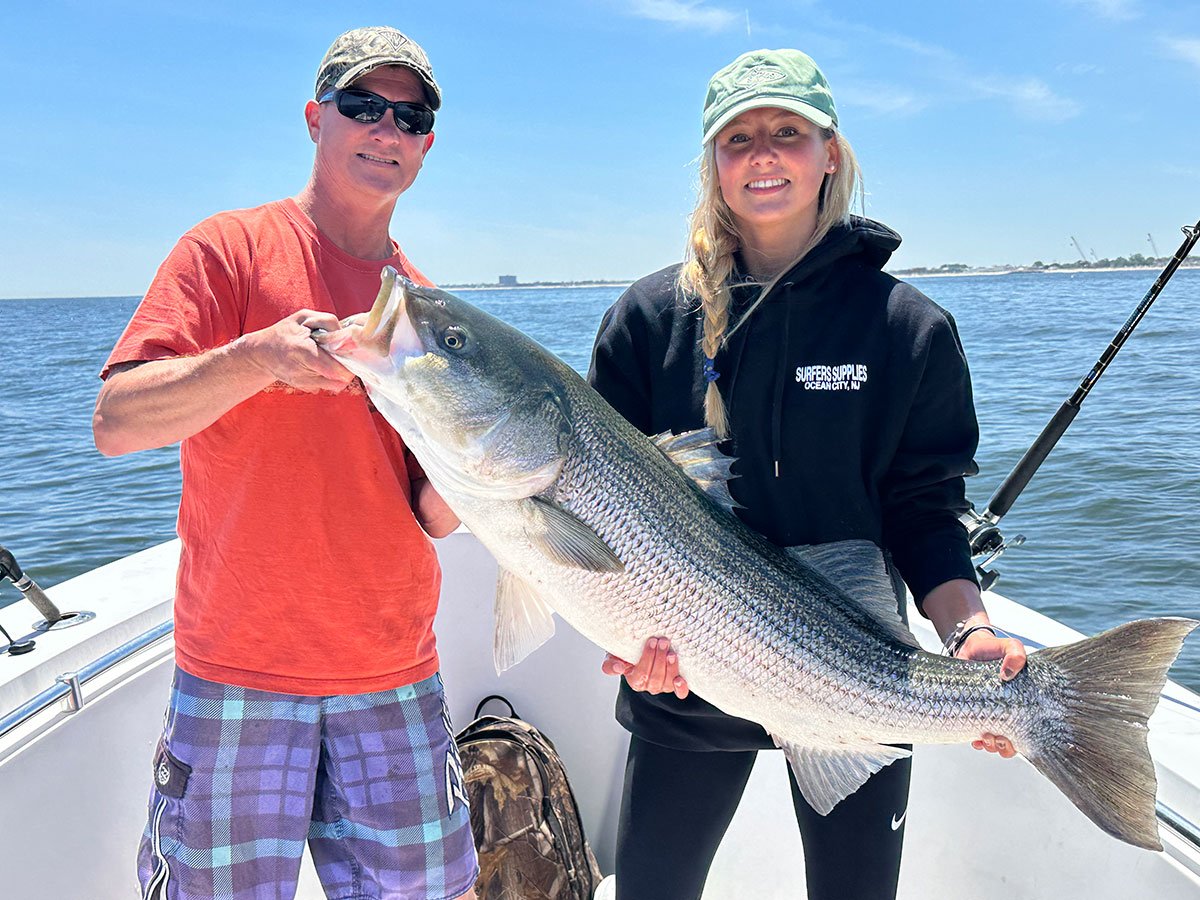
This “spot” was “burned” decades ago, and it just keeps on getting better!
Forget about spot burning, everyone along the entire Striper Coast knows by now that the Raritan Bay complex has become about the most robust striper fishery along the entire Atlantic. And every year seems to be a notch up from the prior in terms of sheer fish volume encountered in every size class. Single fish limits, banning snag-and-drop with trebles and releasing the largest spawners, coupled with tremendous habitat has made the Raritan Bay complex extremely hospitable for striped bass, spring and fall.
The system is composed of shallow flats and shoals interrupted by numerous deep channels and grooves. Adult and peanut bunker that number in the millions call the bay home from early spring until late fall. What’s more, the bay leads to a handful of large rivers that that bass travel in order to procreate and/or feed. The Hudson, Arthur Kill, Raritan, South and Shrewsbury Rivers are fertile, striper-friendly places where huge schools of fish swim year-round.
On the ocean grounds just outside of the bay, waters remain reasonably deep and contain rock, live and muddy bottom. The large variety of tidal entry and exits that contain swift moving water is an attribute to the system. Furthermore, pollution is not what it was in the old days where unregulated dumping took place. It all adds up to practically a year-round striper presence in the overall Raritan complex.
When the action breaks open, boating anglers are best to have a plan that provides them access to the fishery. Multiple private ramps and a municipal launches exist in and around Keyport. In addition, there are also boat launches in Perth Amboy, Leonardo and the Atlantic Highlands on the New Jersey side. Fishermen are best to do research on each ramp to see if it works for their vessel while keeping in mind the condition of the ramp, hours of operation, amount of parking spots available, and most importantly, the depth of the ramp at low water.
Another option for boaters wanting to fish the area is to leave their boat in a transient slip or dry stack. Monthly rates are available at select marinas, and if one is coming from a reasonable distance, this convenience might fit the bill before taking a vessel back to one’s “home waters.” I would be remiss if I didn’t mention the large and flourishing charter and party boat fleet sailing daily. Booking a boat, or even a single spot, is simple and allows experienced captains to put you on the fish quickly and efficiently.
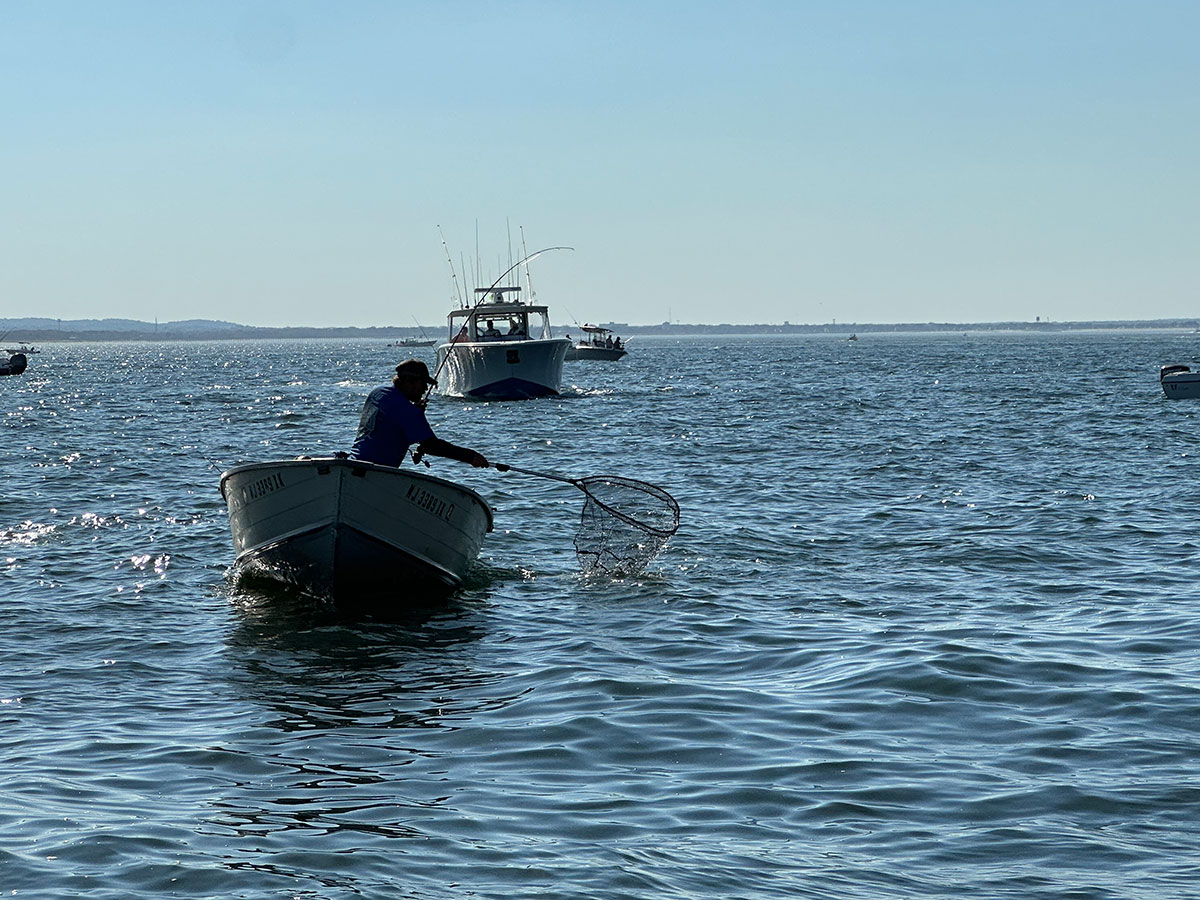
March In Like A Lion
Like many inshore anglers, I like to get my striped bass game going in the spring. Come March, striped bass can be found in any of the aforementioned rivers and that of their smaller tributaries. In actuality, many local fish are there in the dead of winter, but it’s during March that the back bay season official opens and stripers become the target rather than the incidental bycatch when hunting down white perch.
Early in the month, efforts placed toward the rivers will see local, over-wintering fish slowly joined by migratory bass heading up the coast. Sometimes by the third week of March, the entire bay and associated rivers are inundated with ravenous bass that send anglers scurrying to pull the shrink wrap off their vessels. From that time on, the fishing improves daily as new waves of fish move into the system and become highly active. Places like the Keyport Flats and the Triangle have become consistent producers in late March, all of April and into May.
It’s during the months of April and May that fishing crescendos and bass schools may pop up anywhere in the bay and out to the mouth of the ocean. Huge fish ranging from 30 to 50 pounds or more begin to show in abundance. These fish will actually trek up the bay and join the school-sized fish. The waters near the Ammo Pier, Old Orchard, Sandy Hook Bay, the Sticks and any of the shoals will hold oceanic schools of stripers. Spots that reside closer to the ocean are apt to hold higher numbers of jumbos.
Moreover, the run of cow stripers cranks up in the ocean right in front of the bay and can be experienced through much of June. Anglers have the choice at this time of year whether to target larger “fins and grins” fish that are in proximity of the ocean versus the slot-sized eaters that are more frequently encountered further up the bay.
Although not considered striped bass months July and August still hold plenty of stripers albeit they are best targeted at daybreak, dusk and dark. September sees local fish that never left the bay joined by migratory fish on their return south, which in turn, leads to outstanding October action. Mid-October through November is the fall version of the April and May’s hot fishing in terms of insane action within the bay confines. Blitzes and lit up fishfinders can be found more frequently. If weather fronts and temperatures remain reasonable, December can produce terrific tallies, despite a decrease in the size of the bass.
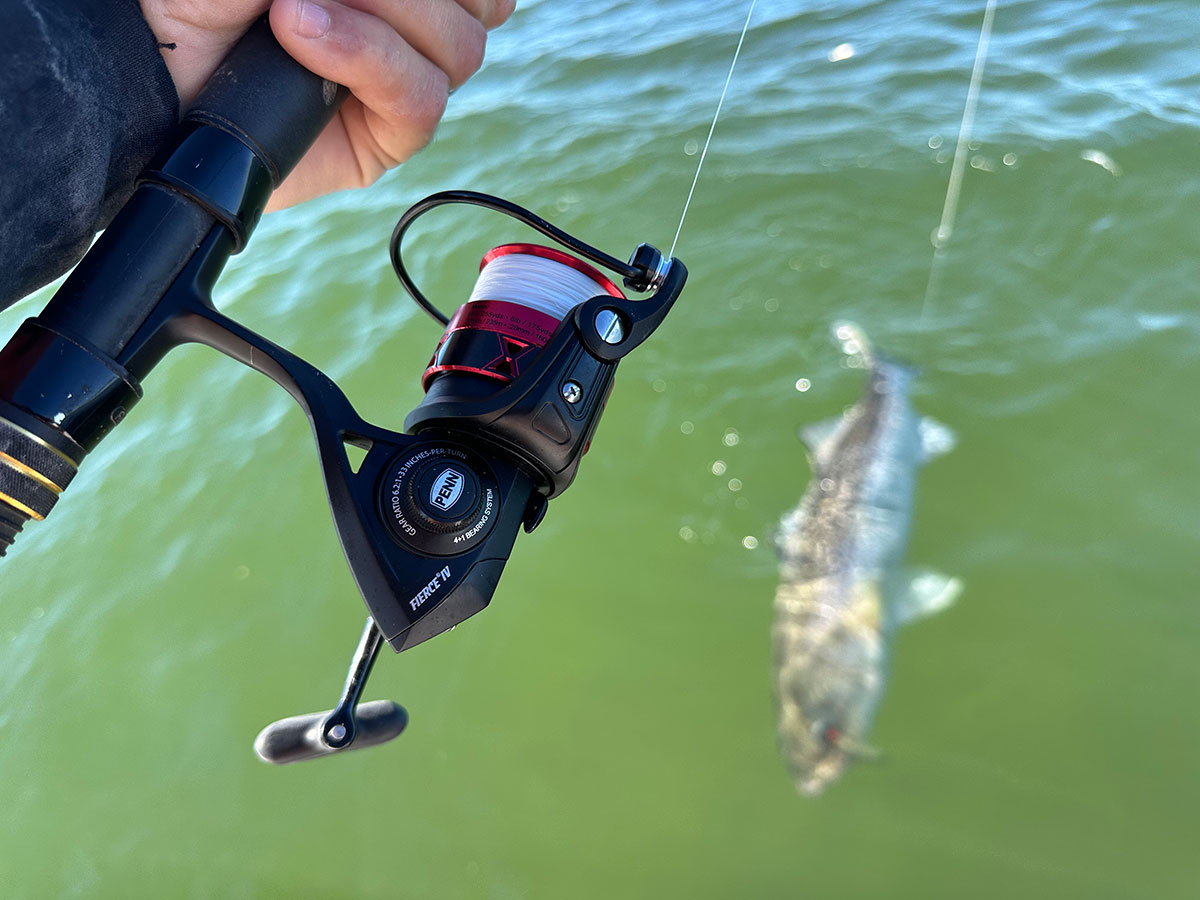
In Lee Of Wind & Fleet
Another fantastic attribute of the bay is that there is often a place to “hide” from the wind and chop; at the very least it can be greatly reduced. The worst conditions take place when a strong wind opposes an outgoing to tide. This situation is less enjoyable because the vessel pitches more. It can be countered by moving further from the mouth of the bay toward the west and getting closer to the land in which the wind is blowing. It’s not uncommon for the entrance to the Raritan to have a stiff breeze and steady chop while simultaneously waters near Keyport or Great Kills are substantially calmer. Educated anglers fish the Raritan in craft as small as kayaks because they take time to learn the nuances of when and where the bay can be as flat as a farm pond.
Finding the fish of course is the first order of business; finding birds and bait, while seemingly of need, is not equivalent to finding the actual bass. Captains must comprehend what bait versus bass look like on their sounder and go on the hunt. You can no doubt join the fleet, or head in the direction where bass were reported the day before. Schools sometimes remain in an area for days or even weeks, and by riding in the direction where bass were caught recently, anglers have the opportunity to scan for fish on the way.
In both spring and fall, bass may show themselves on the surface in boiling or blitz situations! If not, it may take a trained eye to observe their presence on the fishfinder. There have been days I rode for an hour-plus, checking each corner of the bay before placing a line in the water where the depth machine showed me what I wanted. Randomly dropping lines in a ball of bait without bass marks is the last resort after a failed hunt for quality fish marks. The Raritan Bay, while considered “big water,” can be covered better than some places. An aggressive hunt proves fruitful far more than not since there are many schools of bass cruising and feeding on the bay. Some anglers might catch on the western side of the bay simultaneous to when mid-bay and waters meeting the ocean are lit up as well. Fish school up and feed in numerous locations at the same time for certain.
If a captain crushes the fish in one portion of the bay and the bite fizzles out, it’s time to move. There are often feeds taking place in different places when one area dies out. It’s not uncommon for an all-out bite to rev up near where the action dissipated. Additionally, the tide is a major factor in their feeding patterns as a slow bite is often rejuvenated on the turn of the tide.
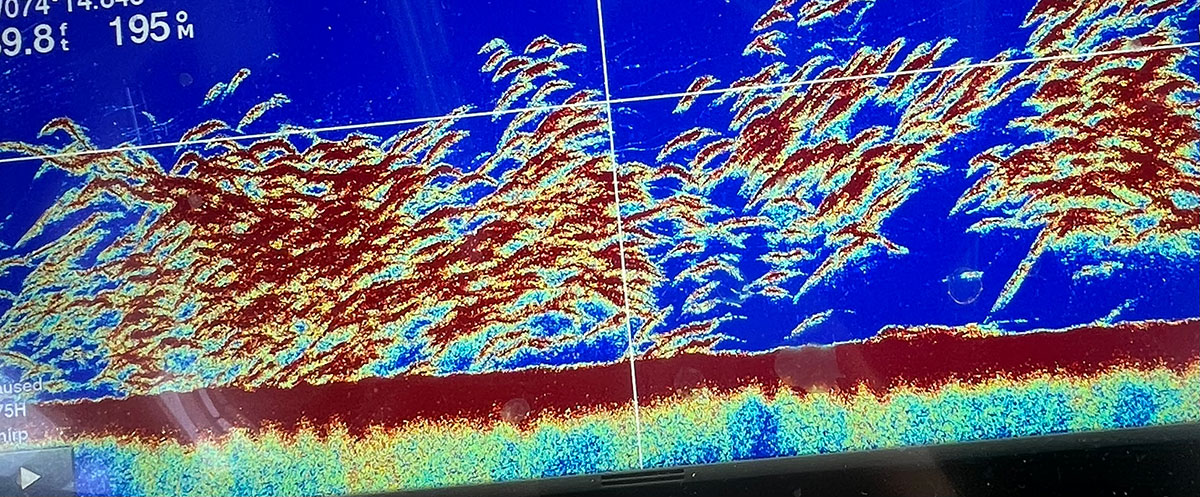
A Tactical Approach
I find casting swimming plugs, pencils and poppers are always at the top of my list on the Raritan; the J-Walker 120, Cane, and Drift Walker by Berkley are excellent choices along with Savage Gear’s Panic Pencil. Subsurface minnows and swim shads lend themselves to a high catch rate and are easier for novices as well. Tsunami swim shads in each size are good to have on the boat, as too are NLBN swim shads and jigheads. Casting to boiling bass that are spotted on the surface is the obvious time to break out any of these presentations; however, don’t disregard the continuation of the tactic a few minutes after the surface fish have swam on. Anglers that cast to the lee of the feed zone will often find fish that are overlooked by boats jockeying for prime position at the front of the blitz.
Old-school metals still have a place when sand eels join bunker and the slender appearances draw rabid strikes. They can also be dropped toward the bottom before retrieving with a reel-twitch-reel cadence. Plano storage containers and tackle bags are a good way to keep each type of lure available and dry. It’s important to carry a variety of offerings, but it’s also important not to over pack and add a ridiculous amount of gear to the boat. Experience helps anglers find the soft spot between underprepared, prepared and over prepared.
Flutter spoon jigging has become the method of choice and it continues to grow in popularity. I found that when Tony Maja introduced his “drift” spoons it was an easy decision to use his product considering his company has been on the lead edge of bunker imitations and spoons for decades. But flutter spoons by various manufacturers can be sent deep in the column or jigged toward the surface with success. Their size and weight allow them to be pitched far from the boat if desired. Seasoned veterans will maneuver the vessel in order to stay over the marks where anglers can employ the tactic they like best.
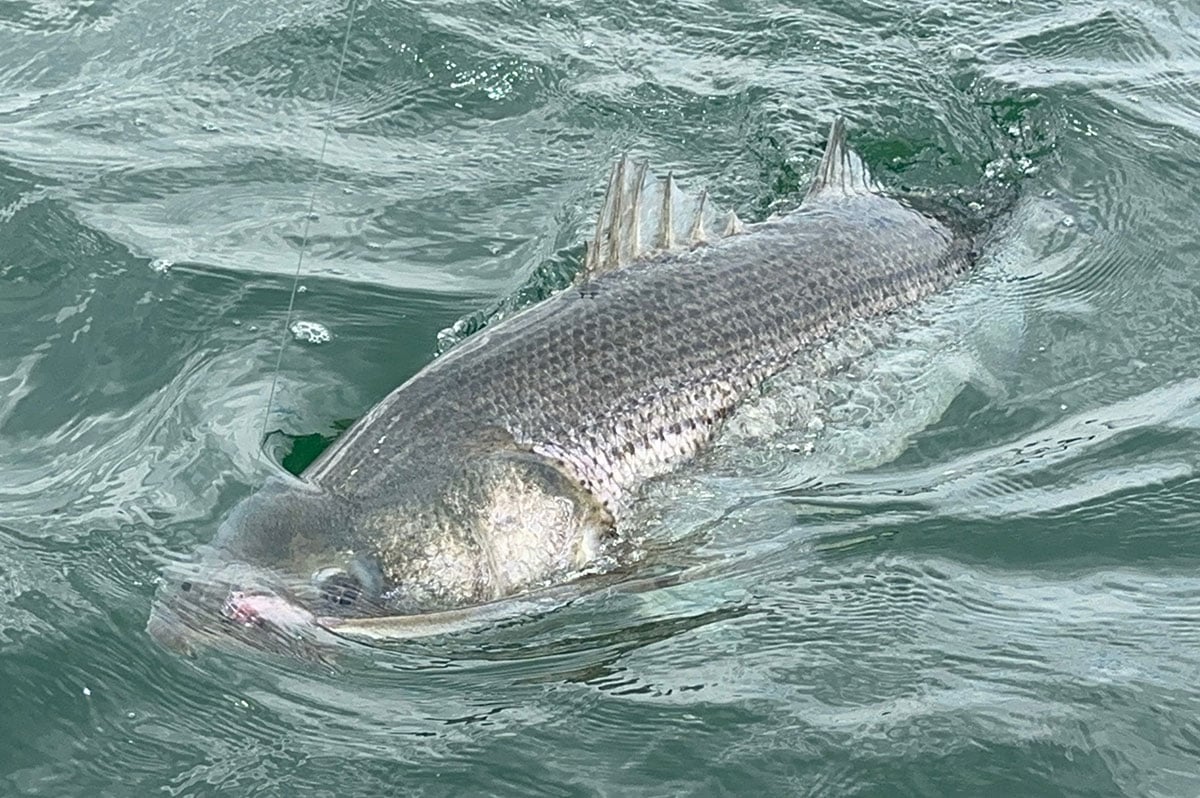
Livelining on the Raritan is another great way to catch. You can cast net bait on the open bay, rivers or marinas when seen flipping on the surface or marked in clouds on the sounder. It is easier to cast net pogies in the marinas, basins, harbors and creeks versus the open bay or ocean where they are more apt to swim out from the net. Many of the best charter and recreational boats procure a well full of bait before they head out in search of bass marks.
Live bait strategy is similar to that of other presentations. Captains need to find bass on top or on the scope before sending circle-hooked bunker into the zone. Fishing lifeless water is probably the number one mistake a captain can make. Bass marks on the bottom machine are a must or anglers need to keep searching even if it takes time. When lines are deployed over bass marks, the bites usually come fairly quick. Of note, the Raritan has a layer of muddy muck in many places so a bait that is sent all the way to the bottom must be checked for cleanliness from time to time.
| REASON FOR THE SEASON |
| Keep in mind that most of the jumbo striped bass in the Raritan Bay complex this spring are preparing for their spring spawn up the Hudson River (and perhaps other local estuary rivers). In addition to the circle hook mandate when using baits and the one fish at 28- to 31-inch size limit anglers are encouraged to take great care in their catch and release.
Avoid keeping big bass out of the water for too long, refrain from sticking your hands inside the gills, and when taking a quick photo before release make sure to brace the belly horizontally with one hand to support that big belly full of eggs while holding the lip in the other. Before releasing your big striper in the water, help revive her by holding the fish from the jaw (use a Boga grip to help) and allowing water to flow through the mouth and across the gills; this may be best done by the captain putting the boat in gear at slowest throttle speed as the angler holds the bass until she shows that she is ready to be set free. |
Trolling can be “lock and load” on the bay, and even though the other methods are a blast, I don’t stick my nose up at trolling since I get to cover water, observe all that’s to be seen and work my achy elbows just a little less. Talk about doubles, triples and quadruple hook-ups! If one chooses to troll mojos, bunker spoons or umbrella rigs, it’s usually a clean-up provided they get the presentations into the right water column. One word of caution, it’s important for trolling captains to avoid trolling right through dense gatherings of boats that are working different lures or livies. It’s poor etiquette. Rather, they should stay to the periphery of boats and where there are sure to be plenty of bass.
Bluewater Candy Lures tandem mojos are the dependable go-to. Size and weight should be adjusted for the depth of water, but generally they range from light to middle-weight offerings that range 4 to 10 ounces. Every now and again, the mojo bite can stall inexplicably. That’s when it’s time to break out the not-so-secret weapon, the umbrella rigs. I prefer the four-arm Striperbrella by Bluewater Candy Lures, but will readily go to a larger version with more arms. The same concept of getting the presentation low in the column, but not touching the bottom will produce consistent strikes when all else is coming up short.
The Raritan region has no shortage of highways and roads so just remember, if you want in the bass bonanza, it can be accomplished!


